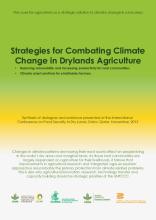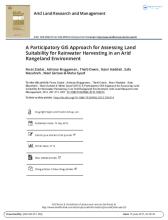Land Library Search
Through our robust search engine, you can search for any item of the over 73,000 highly curated resources in the Land Library.
If you would like to find an overview of what is possible, feel free to peruse the Search Guide.
/ library resources
Showing items 1 through 9 of 15.The purpose of this document is to review the current land characteristics and use status in Yemen as well as agricultural policies and institutional efforts to combat land degradation in the country.
This publication is a baseline assessment reviewing the current knowledge of land degradation in the rangelands of Jordan - known as Badia - with a special focus on its causes.
This publication reviews the historical and current literature on land degradation in Morocco and
presents the results of a case study in the western part of the country. It is intended as a reflection on
Sustainable management of limited land and water resources is urgently needed to meet the increasing demand for food and to protect the environment. Land suitability analysis is a prerequisite in assessing and proposing sustainable land use alternatives for an area.
Synthesis of dialogues and evidence presented at the International Conference on Food Security in Dry Lands, Doha, Qatar, November, 2012
Dryland (arid and semi-arid) ecosystems occupy more than 41% of global land area and are home to 2.5 billion people. More than 50% of South Asia’s dryland ecosystems are located in India.
The dry rangelands of West Asia and North Africa are fragile and severely degraded due to low rainfall and mismanagement of natural resources. Rainwater harvesting (RWH) interventions are used to increase soil moisture content, vegetation cover, and productivity.
This issue of Caravan describes the new program, and some of the research innovations it will build on. The issue begins with two ‘opinion pieces’ by scientists from partner organizations in the CRP.
Poverty, food insecurity, natural resource degradation and climate change are global challenges; but they impact most severely on rural communities in dry areas.









